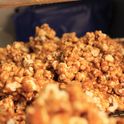Tip to clean sticky / tacky mixer bowl after making dough?
9 Comments
boulangereJune 15, 2013
I agree, Midge. I'd always used not warm, but hot water. But Nancy Silverton advises beginning with cold water to soak the bowl and instruments, then scrub them with a stainless steel scrubber. Then she moves to warm and soapy to actually wash. It works well, and avoids the gumminess that results from warmer water furthering yeast activity. And when my scrubbers get gummed up, as they will but to a much lesser extent than the green side of a sponge, I soak them in a solution of half white vinegar, half water. The gluten breaks down, and the scrubber is almost like new again.
darksideofthespoonJune 15, 2013
I do exactly what halfpint does. Plastic pastry scrapers are amazing!
UgalygirlJune 15, 2013
You probably don't want to keep putting flour down your drains--it's likely that there will be unpleasant consequences sooner or later. Two approaches:
1) use a wet plastic pastry scraper to scrape out the remaining dough; or
2) let it dry out completely, then scrape the bits into the trash.
then wash as usual.
You might also consider mixing a little longer until the dough comes together so that you don't have a sticky, messy bowl--that's usually a pretty good sign that you've mixed sufficiently.
1) use a wet plastic pastry scraper to scrape out the remaining dough; or
2) let it dry out completely, then scrape the bits into the trash.
then wash as usual.
You might also consider mixing a little longer until the dough comes together so that you don't have a sticky, messy bowl--that's usually a pretty good sign that you've mixed sufficiently.
MuttersomeJune 15, 2013
Option 2 is my preferred - it's also easier to remove dried dough.
nutcakesJune 15, 2013
I just made a batch and soaked it for a few minutes in very warm water and it came out right away. I read somewhere that tepid water is better so I used to do this, but just now I found the hotter water melted it away, with just a little swirling with my hand.
HalfPintJune 14, 2013
I usually fill the bowl with hot soapy water and let it sit for at least 15 minutes. Then take a plastic dough scrape and remove the dough. Wash, rinse and dry.
Showing 9 out of 9 Comments
Recommended by Food52
Popular on Food52
Continue After Advertisement




